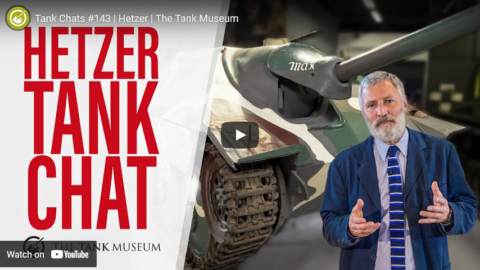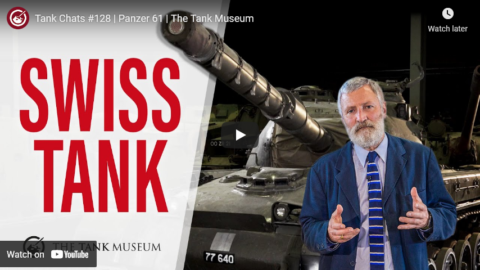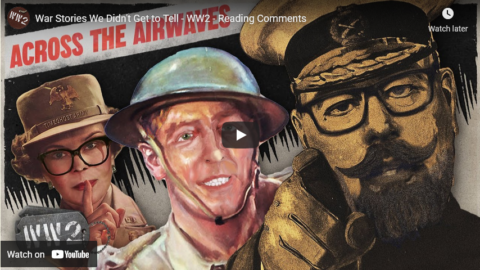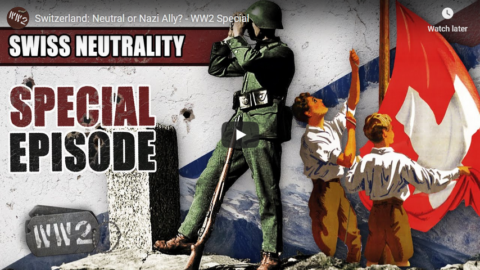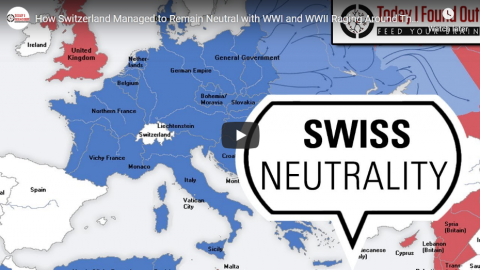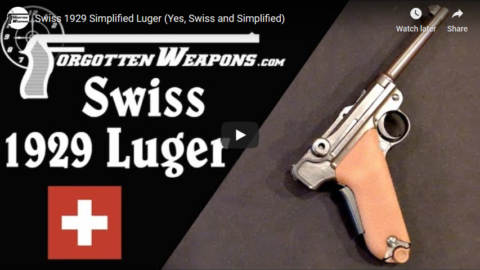The Tank Museum
Published 31 Dec 2021Our Patreons have already enjoyed Early Access and AD free viewing of our weekly YouTube video! Consider becoming a Patreon Supporter today: https://www.patreon.com/tankmuseum
The Munich Agreement averted the outbreak of war but for Czechoslovakia, it meant giving way to German occupation. Join David Willey to discover how Germany was able to use the country’s existing military outputs to build the tank destroyer, Hetzer.
00:00 – Intro
00:28 – The history of the tank destroyers name
14:55 – Wartime productionVisit The Tank Museum SHOP & become a Friend: ►tankmuseumshop.org
Twitter: ► https://twitter.com/TankMuseum
Instagram: ► https://www.instagram.com/tankmuseum/
#tankmuseum #tanks
April 16, 2022
Tank Chats #143 | Hetzer | The Tank Museum
March 9, 2022
Switzerland – The Heart of European Spying – WW2 – Spies & Ties 14
World War Two
Published 8 Mar 2022As a neutral country surrounded by occupied and axis countries, Switzerland was a major spy hub during World War Two. Surrounded by the Swiss Alps, the Axis and Allies fought a parallel spy war to get the upper hand.
(more…)
January 29, 2022
German Soldiers March Through Paris – The End of the Franco-Prussian War
Real Time History
Published 27 Jan 2022https://patreon.com/realtimehistory – support future Real Time History series on Patreon
The end of the Franco-Prussian War is marked by humiliation for France. German soldiers march into Paris and the French Army of the East under Bourbaki flees to neutral Switzerland to surrender there.
» THANK YOU TO OUR CO-PRODUCERS
John Ozment, James Darcangelo, Jacob Carter Landt, Thomas Brendan, Kurt Gillies, Scott Deederly, John Belland, Adam Smith, Taylor Allen, Rustem Sharipov, Christoph Wolf, Simen Røste, Marcus Bondura, Ramon Rijkhoek, Theodore Patrick Shannon, Philip Schoffman, Avi Woolf,» OUR PODCAST
https://realtimehistory.net/podcast – interviews with historians and background info for the show.» LITERATURE
Arand, Tobias: 1870/71. Der Deutsch-Französische Krieg erzählt in Einzelschicksalen. Hamburg 2018Bauer, Gerhard u.a. (Hrsg.): Ausst.-Kat. MHM Dresden‚ Krieg – Macht – Nation. Wie das deutsche Kaiserreich entstand. Dresden 2020
Bolek, Nina: “Die Regelungen des Frankfurter Friedensvertrages zur Kriegerbestattung”, in: Das Schlachtfeld von Woerth – Geschichtsort, Erinnerungsort, Lernort, hrsg. v. T. Arand und Ch. Bunnenberg. Münster. 2012: 109-130
Buk-Swienty, Tom: Feuer und Blut. Hauptmann Dinesen. Hamburg 2014
Gouttman, Alain: La grande défaite. 1870-1871. Paris 2015
Joland, Gérard: “La variole et la guerre de 1870”, in Les Tribunes de la santé 33/4 (2011): 25-30
Tomasetti, Philippe: “L’œvre des tombes et des prières et l’érection des premiers monuments commémoratifs français de la guerre de 1870-1871”, in: L’Outre-Fôret 155 (2011): 3-17
» SOURCES
Deuerlein, Ernst: Die Gründung des Deutschen Reichs 1870/71 in Augenzeugenberichten. Gerlingen 2011 (Neuauflage)Engels, Friedrich: Der Deutsch-Französische Krieg. Sechzig Artikel aus der “Pall Mall Gazette”. Berlin (Ost) 1957
Gerstäcker, Friedrich: “Um Paris herum. IV. Die Brücke von Sèvres”, in: Die Gartenlaube, Heft 11 (1871). SW. 183-186
Goncourt, Edmond de: Journal des Goncourts. II.1. 1870-1871. Paris 1890
Pietsch, Ludwig: Von Berlin bis Paris. Kriegsbilder 1870-1871. Berlin 1871
Reich-Gesetzblatt Nr 26. 1871. Berlin 1872
Russell, William Howard: My diary during the last great war. London 1874
Schellendorf, Paul Bronsart von: Geheimes Kriegstagebuch 1870-71, hrsg. v. Peter Rassow. Bonn 1954
Zeitz, Karl: Kriegserinnerungen eines Feldzugsfreiwilligen aus den Jahren 1870 und 1871. Altenburg 1905
» OUR STORE
Website: https://realtimehistory.net»CREDITS
Presented by: Jesse Alexander
Written by: Cathérine Pfauth, Prof. Dr. Tobias Arand, Jesse Alexander
Director: Toni Steller & Florian Wittig
Director of Photography: Toni Steller
Sound: Above Zero
Editing: Toni Steller
Motion Design: Philipp Appelt
Mixing, Mastering & Sound Design: http://above-zero.com
Maps: Battlefield Design
Research by: Cathérine Pfauth, Prof. Dr. Tobias Arand
Fact checking: Cathérine Pfauth, Prof. Dr. Tobias ArandChannel Design: Battlefield Design
Contains licensed material by getty images
All rights reserved – Real Time History GmbH 2022
January 17, 2022
The shooting range where you fire over a busy road
Tom Scott
Published 18 Oct 2021The Brünnlisau shooting range in Switzerland has its targets on the other side of a major road. And it’s safe. Here’s how and why. Thanks to everyone at the Schiessanlage Brünnlisau!
Camera: Alicja Pahl
Producer: Sebastian Capeda at Viven https://viven.ch
Editor: Michelle Martin https://twitter.com/mrsmmartinI’m at https://tomscott.com
on Twitter at https://twitter.com/tomscott
and on Instagram as tomscottgo
December 21, 2021
Tank Chat #136 | Schützenpanzer | The Tank Museum
The Tank Museum
Published 3 Sep 2021David Willey is back with another Tank Chat! This week’s episode is all about the Schützenpanzer. A West German infantry fighting vehicle developed from 1956 to 1958.
Support the work of The Tank Museum on Patreon: ► https://www.patreon.com/tankmuseum
Visit The Tank Museum SHOP & become a Friend: ► tankmuseumshop.orgTwitter: ► https://twitter.com/TankMuseum
Instagram: ► https://www.instagram.com/tankmuseum/
#tankmuseum #tanks
October 29, 2021
QotD: Another proof of Parkinson’s “Law of the Custom-Built Headquarters Building”
The organisation [the League of Nations] lingered on and, with a final irony, it was now that it assumed the outward shape that is generally associated with it. The Palace of Nations [Wiki], begun in 1929, was finished in 1936, just in time to become a mausoleum. Here at last were the necessary offices, 700 of them, and the fitting conference rooms for the words that no longer meant anything. There was a floor of Finnish granite, walls and pillars faced with Swedish marble, enigmatic and forbidding murals, depicting Technical Progress, Medical Progress, Social Progress, the Abolition of War, and so on, by the Catalan artist Jose Maria Sert. Under their sombre painted sermons, the Assemblies still met and passed their resolutions; everyone was still very busy. But underneath it all the mainspring was broken.
John Terraine, The Mighty Continent, 1974, quoted by Brian Micklethwait, 2021-07-20.
October 14, 2021
Tank Chats #128 | Panzer 61 | The Tank Museum
The Tank Museum
Published 4 Jun 2021Curator David Willey examines one of Switzerland’s first indigenously designed and produced tanks, the Panzer 61, put into service during the Cold War.
Support the work of The Tank Museum on Patreon: ► https://www.patreon.com/tankmuseum
Visit The Tank Museum SHOP & become a Friend: ►tankmuseumshop.orgTwitter: ► https://twitter.com/TankMuseum
Instagram: ► https://www.instagram.com/tankmuseum/
#tankmuseum #tanks
June 9, 2021
Do the Nazis Have Atomic Bombs? – WW2 – Spies & Ties 03 – Sam & Erwin part 2
World War Two
Published 8 Jun 2021All belligerents are working hard to develop a powerful nuclear super-weapon. The Americans wonder how far along the Germans are, and send in their spies.
(more…)
April 14, 2021
War Stories We Didn’t Get to Tell – WW2 – Reading Comments
World War Two
Published 13 Apr 2021Another edition of Across the Airwaves, where Indy, Sparty, and Astrid look at interesting and unique comments from our videos. In this episode, some amazing war stories that we didn’t get to tell.
Join us on Patreon: https://www.patreon.com/TimeGhostHistory
Or join The TimeGhost Army directly at: https://timeghost.tvFollow WW2 day by day on Instagram @ww2_day_by_day – https://www.instagram.com/ww2_day_by_day
Between 2 Wars: https://www.youtube.com/playlist?list…
Source list: http://bit.ly/WW2sourcesHosted by: Indy Neidell, Spartacus Olsson, and Astrid Deinhard
Director: Astrid Deinhard
Producers: Astrid Deinhard and Spartacus Olsson
Executive Producers: Astrid Deinhard, Indy Neidell, Spartacus Olsson, Bodo Rittenauer
Creative Producer: Maria Kyhle
Post-Production Director: Wieke Kapteijns
Edited by: Karolina Dołęga
Sound design: Marek Kamiński
Map animations: Eastory (https://www.youtube.com/c/eastory), Karolina DołęgaSources:
– Bundesarchiv
– Library of Congress
– Australian War Memorial
– Icons from the Noun Project: Boat by Richard Cordero, captain by Gan Khoon Lay, Mine Ship by Luke Anthony Firth, Wrench by Gregor Cresnar
– Explosion animation by Ignisium from YouTube
– Uboat.net, picture of SS Oklahoma courtesy of Texaco ArchivesSoundtracks from Epidemic Sounds:
– “Other Sides of Glory” – Fabien Tell
– “London” – Howard Harper-Barnes
– “Deflection” – Reynard Seidel
– “The Inspector 4” – Johannes Bornlöf
– “What Happens in the Park” – Claude SignetArchive by Screenocean/Reuters https://www.screenocean.com.
A TimeGhost chronological documentary produced by OnLion Entertainment GmbH.
From the comments:
World War Two
2 hours ago (edited)
Day in day out, we review thousands of comments from people across the world. It’s always heartening to come across the ones that are particularly interesting, educational, touching, or even funny. This format, “Across the Airwaves”, is a great way for us to interact directly with our community and in this episode, Indy, Sparty and Astrid mainly look at comments from people offering extra details and analysis that we didn’t have the chance to include in our regular content.Hope you enjoy hearing them. A big thanks to our community, especially our TimeGhost Army members.
March 1, 2021
Solothurn S18-1000: The Pinnacle of Anti-Tank Rifles
Forgotten Weapons
Published 13 Oct 2017Among all the antitank rifles developed between the World Wars, the highest quality and most sophisticated was the Solothurn S18-1000. It fires the 20x138B cartridge which was also used in the Finnish Lahti L-39 and the German 20mm Flak guns, and it does so using a semiautomatic action and an 8-round box magazine. It is a short-recoil system, with a rotating bolt rather similar to that of the MG-34 machine gun.
The recoil-operated action of the Solothurn helps dampen its recoil more than the Lahti, and is definitely a more comfortable gun to shoot. The Solothurn is equipped with both iron sights and an optical sight (we used the irons in this shooting, because the rubber eye cup on the scope is fairly hard and brittle on this example). Remarkably for its 100+ pound weight, the gun definitely jumps back a few inches when fired unless one has firmly sunk the bipod feet into the earth. However, the recoil force is really more of a push than a sharp impact, and combined with the large surface area of the shoulder pad it is not at all a bad experience.
A number of different countries bought the S18-1000 (and many others bought the smaller S18-100), including the Italians and Hungarians. The only combat account I was able to find was from a Dutch antitank gun team that used one to successfully engage several German armored cars during the invasion of the Netherlands in 1940.
http://www.patreon.com/ForgottenWeapons
Cool Forgotten Weapons merch! http://shop.bbtv.com/collections/forg…
If you enjoy Forgotten Weapons, check out its sister channel, InRangeTV! http://www.youtube.com/InRangeTVShow
February 10, 2021
One Advantage of Swiss Neutrality: LSD! – WW2 – Reading Comments
World War Two
Published 9 Feb 2021Another edition of Across the Airwaves, where Indy and Sparty look at interesting and unique comments from our videos. In this episode, they look at gentlemanly declarations of war, Partisan memories, and LSD.
Join us on Patreon: https://www.patreon.com/TimeGhostHistory
Or join The TimeGhost Army directly at: https://timeghost.tvFollow WW2 day by day on Instagram @ww2_day_by_day – https://www.instagram.com/ww2_day_by_day
Between 2 Wars: https://www.youtube.com/playlist?list…
Source list: http://bit.ly/WW2sourcesHosted by: Indy Neidell & Spartacus Olsson
Director: Astrid Deinhard
Producers: Astrid Deinhard and Spartacus Olsson
Executive Producers: Astrid Deinhard, Indy Neidell, Spartacus Olsson, Bodo Rittenauer
Creative Producer: Maria Kyhle
Post-Production Director: Wieke Kapteijns
Edited by: Karolina Dołęga
Sound design: Marek Kamiński
Map animations: Eastory (https://www.youtube.com/c/eastory)Colorizations by:
– Daniel Weiss
– Mikołaj Uchman
– JHM Color
– Julius Jääskeläinen – https://www.facebook.com/JJcolorization/Sources:
– Imperial War Museums: MH 1324, CH 1533, HU111054, TR 1468, MGH 4464
– National Archives NARA
– United States Holocaust Memorial Museum
– Yad Vashem: 4360-99, 2725-5, 4788-73,
– Bundesarchiv
– Picture of Soviet Soldiers with DShK-38 gun courtesy of Leduytoan2003 from Wikimedia Commons
– Picture of 19th Army troops storming Mogile courtesy of Mil.ruSoundtracks from Epidemic Sound:
– “The Unexplored” – Philip Ayers
– “The Inspector 4” – Johannes Bornlöf
– “London” – Howard Harper-Barnes
– “Document This 1” – Peter Sandberg
– “Dark Beginning” – Johan Hynynen
– “Rubik’s Cube” – From Now On
– “Getaway Rock” – Elliot HolmesArchive by Screenocean/Reuters https://www.screenocean.com.
A TimeGhost chronological documentary produced by OnLion Entertainment GmbH.
November 25, 2020
Switzerland: Neutral or Nazi Ally? – WW2 Special
World War Two
Published 24 Nov 2020After the fall of France in June 1940, neutral Switzerland found itself surrounded on all sides by a hostile expansionist power. The small nation would have been a valuable possession but the jaws of the Reich hesitated to swallow it. How did Switzerland manage to exit the conflict intact and largely unscathed?
Join us on Patreon: https://www.patreon.com/TimeGhostHistory
Or join The TimeGhost Army directly at: https://timeghost.tvFollow WW2 day by day on Instagram @ww2_day_by_day – https://www.instagram.com/ww2_day_by_day
Between 2 Wars: https://www.youtube.com/playlist?list…
Source list: http://bit.ly/WW2sourcesHosted by: Spartacus Olsson
Written by: Lennart Visser & Francis van Berkel,
Director: Astrid Deinhard
Producers: Astrid Deinhard and Spartacus Olsson
Executive Producers: Astrid Deinhard, Indy Neidell, Spartacus Olsson, Bodo Rittenauer
Creative Producer: Maria Kyhle
Post-Production Director: Wieke Kapteijns
Research by: Lennart Visser
Edited by: Karolina Dołęga
Sound design: Marek Kamiński
Map animations: Eastory (https://www.youtube.com/c/eastory)Colorizations by:
Adrien Fillon – https://www.instagram.com/adrien.colo…
Cassowary ColorizationsSources:
– Pictures of Swiss Army by Strübin Theodor courtesy of Archäologie und Museum Baselland Lizenzbedingungen
– Bundesarchiv
– Imperial War Museums: HU56131
– ETH-Bibliothek Zürich: 03258, LBS MH05-02-04, M01-0756-0001
– Fortepan:3889, 92301
– National Archives
– Staatsarchiv Bern – P362
– Plan of the defence lines of the National Redoubt courtesy of Auge=mit from Wikimedia Commons
– Picture of Swiss Soldiers with anti-aircraft gun courtesy of Paebi from Wikimedia Commons
– Picture of Swiss aircraft in 1943 from theM.Pilloud – Archive familiale
– United States Holocaust Memorial MuseumSoundtracks from Epidemic Sound:
– “Other Sides of Glory” – Fabien Tell
– “Moving to Disturbia” – Experia
– “Remembrance” – Fabien TellArchive by Screenocean/Reuters https://www.screenocean.com.
A TimeGhost chronological documentary produced by OnLion Entertainment GmbH.
From the comments:
World War Two
1 hour ago
As we draw close to the end of 1941, it becomes clear that neutrality is not a guarantee of safety. Its utility as a diplomatic strategy has been discarded and is non-existent.A total of 12 sovereign and neutral nations have been invaded by Allied or Axis powers since the beginning of the war — Denmark and Norway on 9 April 1940; Belgium, the Netherlands, Iceland and Luxembourg on 10 May 1940; Lithuania on 15 June 1940 and Latvia and Estonia on 17 June; Greece on 28 October 1940 and Yugoslavia in April 1941; Iran in August 1941. Even those that are spared are compelled to assist either the Allies or the Axis or both in financial and economic terms, such as Switzerland and Sweden. Others offer voluntary military assistance such as Portugal and Spain.
February 22, 2020
How Switzerland Managed to Remain Neutral with WWI and WWII Raging Around Them
Today I Found Out
Published 30 Apr 2018Signup for your FREE trial to The Great Courses Plus here: http://ow.ly/dCMa30hIugB
If you happen to like our videos and have a few bucks to spare to support our efforts, check out our Patreon page where we’ve got a variety of perks for our Patrons, including Simon’s voice on your GPS and the ever requested Simon Whistler whistling package: https://www.patreon.com/TodayIFoundOut
The Great Courses Plus is currently available to watch through a web browser to almost anyone in the world and optimized for the US, UK, and Australian markets. The Great Courses Plus is currently working to both optimize the product globally and accept credit card payments globally.
Never run out of things to say at the water cooler with TodayIFoundOut! Brand new videos 7 days a week!
In this video:
The tiny mountainous country of Switzerland has been in a state of “perpetual neutrality” since the major European powers of the time declared it as such during the Congress of Vienna after the end of the Napoleonic wars in 1815.
Want the text version?: http://www.todayifoundout.com/index.p…
December 6, 2019
“The Last Stand” – The 1527 Sack of Rome – Sabaton History 044 [Official]
Sabaton History
Published 5 Dec 2019In 1527, a large Holy Roman army consisting of Germans, Spaniards and Italians march on Rome frustrated over unpaid wages and lacking supplies. Pope Clement VII seeks shelter as Rome is pillaged and burned while his brave Swiss Guard makes a heroic last stand.
Support Sabaton History on Patreon: https://www.patreon.com/sabatonhistory
Listen to The Last Stand (where “The Last Stand” is featured):
CD: http://bit.ly/TheLastStandStore
Spotify: http://bit.ly/TheLastStandSpotify
Apple Music: http://bit.ly/TheLastStandItunes
iTunes: http://bit.ly/TheLastStandItunes
Amazon: http://bit.ly/TheLastStandAmz
Google Play: http://bit.ly/TheLastStandGooglePlayWatch the official lyric video of “The Last Stand” here: https://www.youtube.com/watch?v=BwfJs…
Listen to Sabaton on Spotify: http://smarturl.it/SabatonSpotify
Official Sabaton Merchandise Shop: http://bit.ly/SabatonOfficialShopHosted by: Indy Neidell
Written by: Markus Linke and Indy Neidell
Directed by: Astrid Deinhard and Wieke Kapteijns
Produced by: Pär Sundström, Astrid Deinhard and Spartacus Olsson
Creative Producer: Joram Appel
Executive Producers: Pär Sundström, Joakim Broden, Tomas Sunmo, Indy Neidell, Astrid Deinhard, and Spartacus Olsson
Post-Production Director: Wieke Kapteijns
Production Intern: Rune Vaever Hartvig
Edited by: Iryna Dulka
Sound Editing by: Marek Kaminski
Maps by: Eastory – https://www.youtube.com/c/eastoryArchive by: Reuters/Screenocean https://www.screenocean.com
Music by Sabaton.Sources:
– Rijksmuseum
– Fondo Antiguo de la Biblioteca de la Universidad de Sevilla
– A massacre in a church during the Sack of Rome: a priest is about to be stabbed and another priest is lying dead on the floor before the altar. Wood engraving by R. Venturi after himself. Credit: Wellcome Collection. CC BY
– Guy de Chauliac bandaging the leg of Pope Clement VII at Avi. Oil painting by Ernest Board. Credit: Wellcome Collection. CC BY
– Photo of Sistine Chapel ceiling by Qypchak
– Photo of Arco delle Campane by Przemek PietrakAn OnLion Entertainment GmbH and Raging Beaver Publishing AB co-Production.
© Raging Beaver Publishing AB, 2019 – all rights reserved.
July 19, 2019
Swiss 1929 Simplified Luger (Yes, Swiss and Simplified)
Forgotten Weapons
Published on 15 May 2019http://www.patreon.com/ForgottenWeapons
Cool Forgotten Weapons merch! http://shop.bbtv.com/collections/forg…
Switzerland was the first nation to adopt the Luger as a service pistol, and they purchased them DWM in Germany from 1900 until 1914. World War One stopped deliveries, of course, and after the war the Swiss opted to begin their own production at Waffenfabrik Bern. These Swiss Lugers have become known as the model 06/24 by collectors, and were made until 1933. During that time, Bern was looking for ways to simplify and economize their production, and these efforts came together with the development of the Model 1929. It actually entered production in 1934, and was made until 1947 with a total of about 28,000 made for the military and about 1,900 made for the civilian market.
The main mechanical change to the 1929 pattern was a lengthening of the grip safety. Other changes included simplifying the profile of the front strap of the grip, removing knurling and serrations on the controls, and only serializing four parts. A production date stamp was also added to the inside of the frame, however.
Contact:
Forgotten Weapons
PO Box 87647
Tucson, AZ 85754

